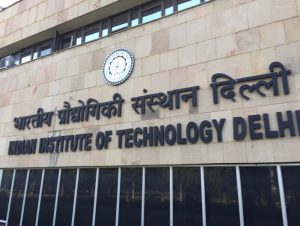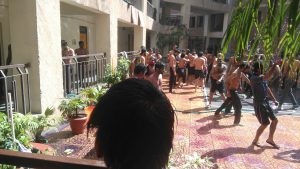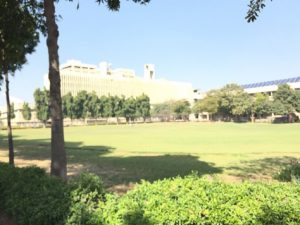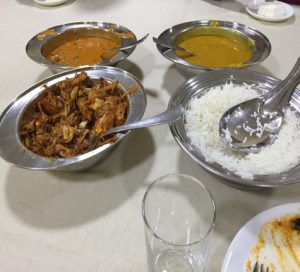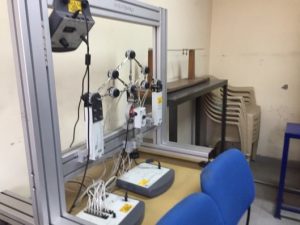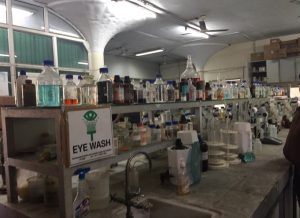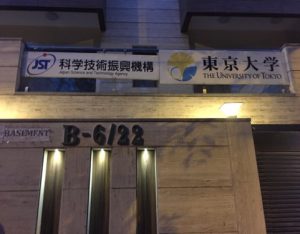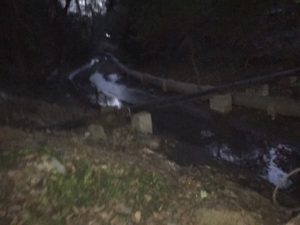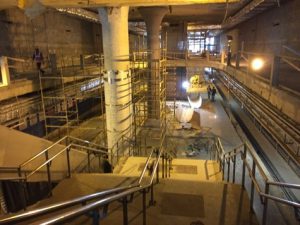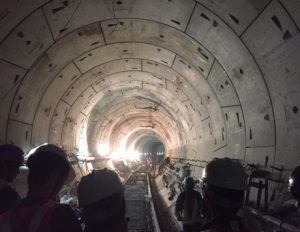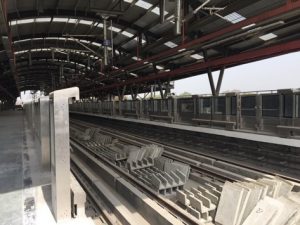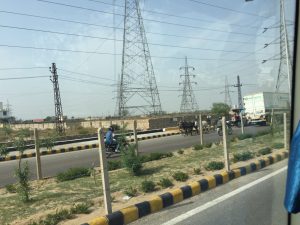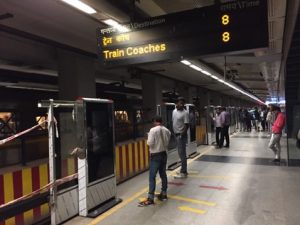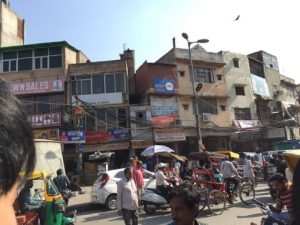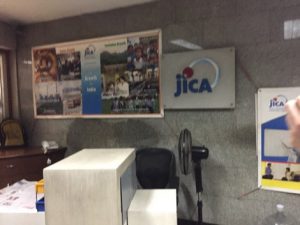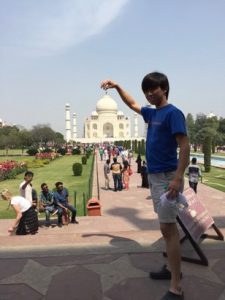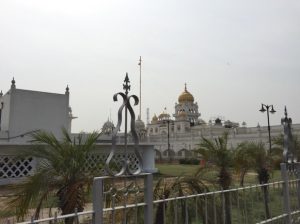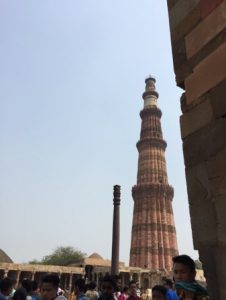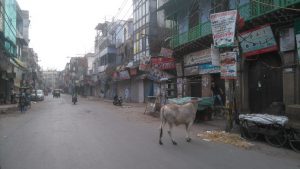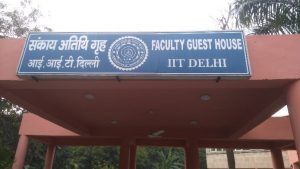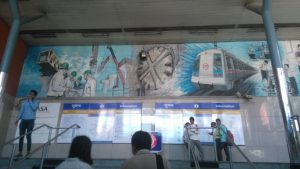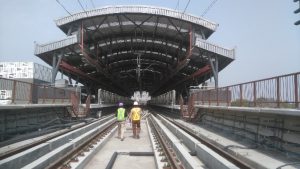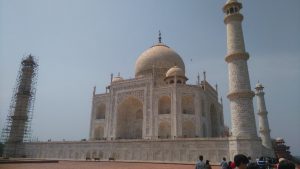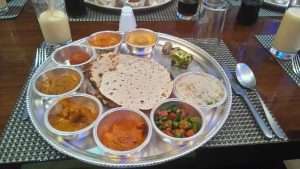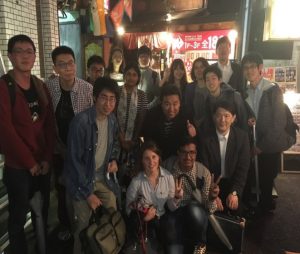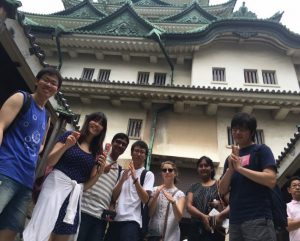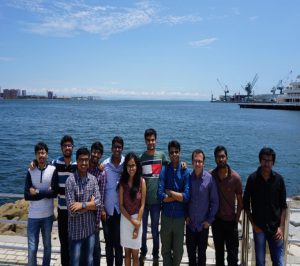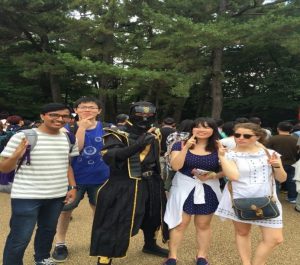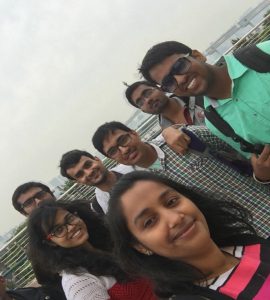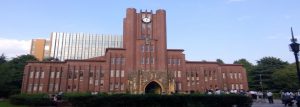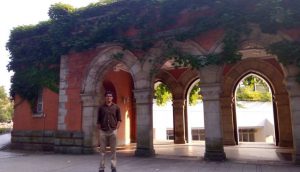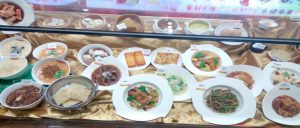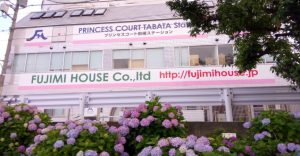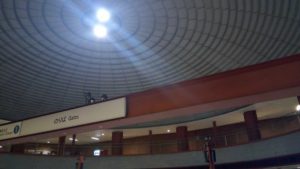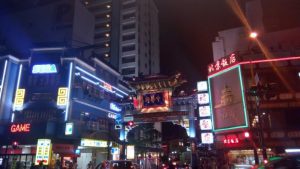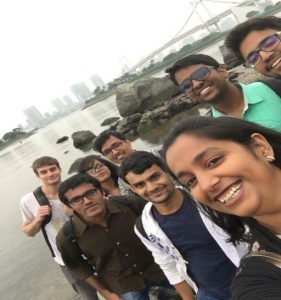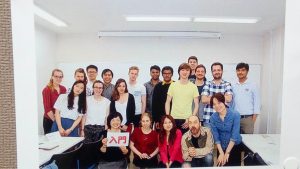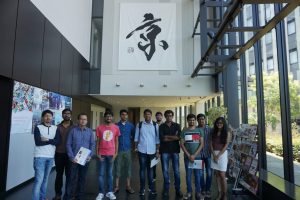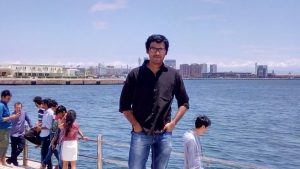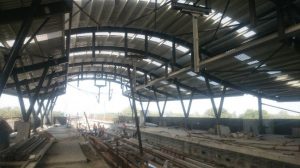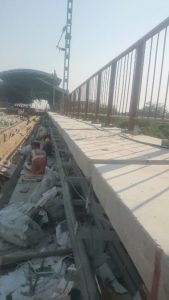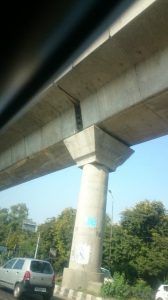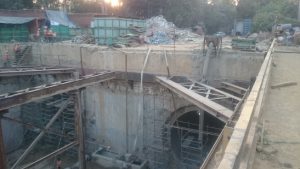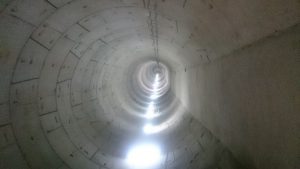Summary of Two Years Stay in Japan
My stay in Japan was very fruitful for the development of my personality as well as of knowledge. I will divide my summary in two parts. In the first part I shall cover my academic experience in Japan including Masters Course, trainings undertaken and site visits etc. In the second part I shall discuss various experiences of my personal life in Japan including travel across Japan and cultural experiences.
Academic Experiences in Japan
- Masters Course at the University of Tokyo
The main purpose of coming to Japan was pursuing Masters Course. We had to complete 20 credits from course work and 10 credits from research work. In Japan greater focus is laid on research related activities in post graduation course which provide in-depth knowledge of the subject and develops problem solving skills in the students. My research area was concrete engineering and topic of research was “Investigation of pre-mature cracking of concrete sleepers in Indian Railways and countermeasures to improve their conditions”. The reason behind choosing this topic was my long experience in Indian Railways where pre-mature cracking of sleepers was the major problem faced during maintenance of track. I summarize my experience of master’s course in the following points
i) Elective courses for class room work
I felt that class room work was comparatively easy. The lectures were given through audio-visual aids like PowerPoint. Whenever an in depth understanding of course, from application point of view was required, there used to be field visits as a part of the class work. The lecturers welcomed questions from students in order to clarify their doubts. Generally, assessment was based on assignments and sometimes written examination was also conducted. Many of the classes included group work which facilitated interaction among students and helped in developing different perspectives for a given problem.
ii) Practical orientation in class room work
All the classes mostly taught theory but practical orientation used to be the major aspect of the class works at the University of Tokyo. Classes like “Infrastructure management”, “Project Management”, “Frontiers of Civil Engineering” etc gave a chance to students to learn the practical field application of science and technology.

Class work at the University of Tokyo

Japanese language classes at the University of Tokyo
iii) Chance to learn Japanese language
The JLC class at the University of Tokyo is very comprehensive and useful for day to day life in Japan. Apart from this we can earn credit for this course which gives additional motivation to join the course. The knowledge of Japanese language is also very useful during travel across Japan.
iv) Help by various experts to support research work
Supervisor and co-supervisor always motivated and supported me for my research work. Since topic of pre-mature cracking was new to my lab as well, therefore at times expert guidance had to be arranged from outside the University of Tokyo as well. For example Associate Professor from Saitama University, Japan and Professor Emeritus, Yamaguchi University, Japan helped me with the material part of my research. The lab meetings were held weekly, where we presented our progress and seeked expert guidance from the supervisor. Combined Lunch meetings, convened once in every two weeks, gave opportunity to present the research work in front of professors and students of other labs and seek their guidance. Also, expert help was arranged from organizations like Japan Cement Corporation, Railway Technical Research Institute and sleeper plants in Japan.
v) Guidance and help by lab mates
The culture of research was very new to me when I joined the University of Tokyo. Taking firsthand guidance from the ones who had already walked the path, was of immense help. The first help was extended by my lab mates. They helped me to understand the practices of the lab, research work etc. as and when required.
vi) Well equipped laboratories
The state of art laboratories in the University of Tokyo are very helpful for the students, in the sense that once the methodology of research is decided, all the ground work is ready before hand and the students can quickly start with their experiments in the experimental room attached to the laboratories. The laboratories are equipped with most of the modern equipments required for the research. There is no dearth of computing facilities in the laboratories. Laboratories also have small libraries where we can easily find the important reference books and papers.

Site visit as part of class work at the University of Tokyo

Lab meetings at the University of Tokyo
again, after such a long gap. I decided to select a research topic related to a problem that I was facing while I was working in Indian Railways. In this way, the problem was already well known to me and I quickly started working under the guidance of my supervisor. In this regards kind support and motivation of my supervisor, co-supervisor and all the other sensei needs special mention, through which not only my fears got dispelled but could win the prestigious Furuichi award.
viii) Direct application of the research results
My research was related to a practical field problem faced while I was working in Indian Railways. In this sense, the results of my research have a direct practical relevance and the same can be utilized to improve the conditions of sleepers in Indian Railways. In my research work I have investigated the problem of pre-mature cracking by collecting extensive samples from Indian Railways, studied the manufacturing processes in the two countries, measured temperature inside concrete sleepers in the set up of a concrete sleeper plant in India and did rigid body spring model simulation for alkali silica reaction (ASR) induced damages and delayed ettringite formation (DEF) induced damages.

Laboratory at IIS, University of Tokyo

Well equipped laboratories at IIS, the University of Tokyo
2. Internship
We underwent two internships while studying at the University of Tokyo. The first was of about a month long internship at Railway Technical Research Institute (RTRI) and second was a one week intensive internship at JR (East). Both the internships were arranged by the kind initiatives of the professors of University of Tokyo. The internships were very informative and useful for us because they gave us a chance to compare the technologies in the two countries and learn the better practices prevalent in Japan. The two internships are explained in detail in following paragraphs:
a) Internship at Railway Technical Research Institute (RTRI)
Period of internship: 17.8.2015 – 11.9.2015
Purpose of visit: This one month long internship was arranged by the University of Tokyo to provide a deeper understanding of the latest researches going on in the field of Railway Technology in Japan. We had been given the status of a visiting researcher in RTRI and also were given a dedicated place with computers and other office facilities to carry out the research work and studies. We worked here with other researchers of RTRI. During the internship, not only could we extend and relate our research with the ongoing studies in RTRI but could also develop a good bond and a co-operative relationship with the researchers of RTRI as well. The internship can be summarised in brief with the following points:
i) Familiarisation with the researches in RTRI
The very first day was dedicated to introduction to the concrete structure lab. Dr. Okamoto gave a brief about the objectives of RTRI. Also, presentation was given for the researches going on in the field of concrete structures. a) There are mainstays and clearly defined objectives for the R&D atRTRI. Their annual budget is around 18.4 billion yen and most of it is paid by the JR companies.

Objectives of RTRI

Compressive strength test, RTRI experimental room
ii. Attending the Compressive Strength test
In Japan concrete sampling is done in cylinders of size 100mm Dia x 200mm height. The concrete specimen cylinder for High Strength Concrete was tested in the experimental room of RTRI. Since high strength concrete does not show considerable deformation before fracture, in order to precisely measure the deflection, a special apparatus was used. The capacity of loading machine was 1000KN and rate of introduction of force was 50 KN/ 10 sec. One specimen of High Strength Concrete tested, took a load of 468 KN.
iii. Research Introduction by Mr. Nihei, Ohno
Often, cracks in the concrete are attributed to Shrinkage by moisture evaporation. In this research topic, the researcher wanted to know the cracking load w.r.t. internal stresses caused by shrinkage and creep of mortar. Shrinkage and creep stress and strain are not generated uniformly. Knowing the distribution of internal stress is important for analysing the cracking load in the member. A special method called “ digital image correlation method” is developed by RTRI to measure non uniform strain.
iv. Visit to Institute of Technology, Tokyu Construction to attend experiment
In the experiment, the performance of ECC panels ( Fibre mortar panels) was being evaluated for the bending performance of the columns. The motivation behind this experiment was that the seismic performance of large number of columns which were built previously had to be enhanced in view of updated codes and practices. The column should fail in bending rather than shear to cause less damage to it due to earthquakes.

Experiment at Tokyu Institute of Technology

Ladder sleeper, Japanese Innovative technology in sleepers
v. Introduction to Concrete Sleepers in Japanese Railways by Mr. T. Watanabe of Railway Dynamics Division
Mr. Tsutomu Watanabe is Asst. Senior Researcher in Structural Mechanics Laboratory of Railway Dynamics Division. He deals with the technology of PSC concrete sleepers in Railways in Japan. He is pioneer in the technology of ladder sleeper. Ladder sleepers are the structural innovation from conventional “Transverse” to “Longitudinal” support system from the tracks. Ladder sleepers are now widely used in Japan because of their better performance compared to conventional ties.
vi. SEM analysis in Material Technology Division by Mr. Koji Tsuruta
One of the main achievements of the internship in RTRI was their support towards my research. My research topic was “ Pre-mature cracking in Railway PSC sleepers in Indian Railways”. I collected many samples of concrete from the railway sleepers in India. All the cracked concrete sleepers showed a particular behaviour in which the cracks start getting visible after 7-10 years of manufacturing. After having discussed with the Professors of the University of Tokyo and having read relevant papers based on similar problems and researches, it was guessed that crack could occur due to Delayed Ettringite Formation( DEF) or Alkali Silica Reaction (ASR). DEF was more guessed since the sleepers were given heat treatment during the production. Mr. Koji Tsuruta of Material Technology Division is expert in this field & he is author of many papers related to similar problem in railway sleepers in Japan. RTRI has very modern Scanning Electron Microscopes (SEM), which do not require any type of carbon coating etc, thus gives accurate results without any bias. The SEM of the damaged concrete samples confirmed large deposition of Ettringite crystals which confirmed severe DEF problem in concrete sleepers. The prima facie cause of DEF can be related to high temperature curing (around 75°C) given to these sleepers during production.

SEM Analysis at RTRI

ASTEA MACS anlysis
vii. Evaluation of Internal heat of hydration in Indian PSC sleepers using software ASTEA MACS
ASTEA MACS is FEM based program for non linear thermal stress analysis. It takes in to account the history of heat generated at the time of construction, the temperature-dependency and time-dependency of material properties, the addition of elements and variation of boundary conditions due to concrete Casting, and the occurrence of cracks etc. I have used this software to evaluate the temperature rise inside the concrete due to steam curing cycle adopted in Indian concrete sleeper plants.
The results of the ASTEA MACS were interesting. The temperature inside the concrete comes out to be almost 83°C (8°C higher compared to the surrounding). This result was important since there is greater probability of occurrence of DEF in case of temperature going higher and higher. Following slides summarise the results:
viii. Visit to Concrete Sleeper plant
This visit has been organised by RTRI to get the idea about the production process of concrete sleepers in Japan. This visit was important for the research purpose since in Japan concrete sleepers are not having DEF problems at large scale. This visit gave us insight about the modern production processes of concrete sleepers and we could compare it with the process adopted in our country. The plant is situated around 200 kms SW of Tokyo. The plant is owned by Kyokuto Kowa Corporation. Kyokuto Kowa Corporation is a big company having 7such plants throughout Japan.
b) Internship at Japanese Railways (East) Co. Ltd.
Period of internship: From 24.9.2015 to 2.10.2015
Purpose of visit: The two weeks internship was arranged by the University of Tokyo in co-operation with JR East. Japan is an undisputed world leader in railway technology. Indian Railways also has the vision to modernise its vast railway network to improve speed and safety. There is plan to connect major commercial and tourist places by High Speed Rail network. Therefore, apart from pursuing the master’s degree and the research, one of our major objectives while studying in Japan is to learn the modern railway technology available here. With the kind initiative of University of Tokyo and generous acceptance by JR East, it was made possible to get a feel of Railway technology & it’s operation and maintenance systems in Japanese Railways. We have spent around 9 years in Indian Railways, thus we have an in depth understanding of existing technology and systems of our country. So, this internship helped us to compare the systems existing in the two countries and we could also learn quickly.
Brief of the internship is as follows:
i) Day 1-24.9.2015:
- Meeting with the executive director of JR East.
- Presentation on outline of structural engineering centre.
- Presentation on Framework of Shinkansen line- planning, financing etc.
- Presentation on design of railway concrete structure by concrete group.
ii) Day2-25.9.2015
- Lecture: Shinkansen Technologies of Japan by Dr. Ishibashi: history and evolution of high speed train engineering
- Presentation on construction and quality control of concrete structure by Concrete group
- Presentation on design of steel structure by steel group
iii) Night visit 25.9.2015&26.9.2015
- Site visit for Shinkansen Rail Grinding work near Omiya station. We had interaction with the maintenance staff but the work was not done because of there was some disruption of Shinkansen running that night to some electrical failure.ay 3-28.9.2015
iv) Day 3-28.9.2015
●Field trip to Shinkansen General Rolling Stock maintenance centre
●Field trip to restoration work site of Joban line damaged due to Tsunami of 2011
v) Day 4-29.9.2015
●Field trip to Niigata- Works related to modification of Niigata station, Viaduct works
vi) Day 5-30.9.2015
●Presentation on general maintenance of structures in JR
●Presentation on Maintenance of concrete structure by concrete structure group
●Presentation on Maintenance of steel structure by steel group

Shinkansen General Rolling Stock Center, Sendai

Joban line reconstruction site
vii) Day 6-1.10.2015
● Field trip to Conventional Line maintenance work site near Kameari station- inspection of viaduct and bridges
viii) Night visit-1.10.2015-2.10.2015
● Field trip to Ueno underground station and tunnel for Shinkansen- inspection of underground station, bridges and tunnels etc, water removal and recycling system.
ix) Day 7-2.10.2015
● Wrap up meeting- feedback, suggestion etc.

Modification of Niigata station works, Niigata

Night maintenance work, Ueno station
3. Seminars
I have attended two main summer seminars. The first one was Urban Rail Seminar and second one was Shinkansen seminar. Both the seminars were arranged by the University of Tokyo in co-operation with Ministry of land and infrastructure and various rail companies of Japan. The seminars were very informative and attended by students from various Universities across Japan. Lectures by distinguished heads of various organizations and rail companies followed by field visits gave an in depth knowledge of the subject. Briefs of the two seminars are as follows:
a) Special Summer Seminar for International Students 2015 “Railway System and Urban Development of Mega Cities”
Period: 27.8.2015-28.8.2015 (2 days )
This seminar was organised by the University of Tokyo in co-operation with various Railway companies in Japan. As a matter of policy, Japan wants to support the development of modern railway systems in Asian countries and promote it’s technology throughout the world. During last half century, Japanese Railway System has witnessed rapid growth, not only in terms of volume but in technological innovation as well. Apart from High Speed Train, the urban rail system is also quite developed in Japan. It’s success can be guessed from the fact that on an average almost 80% of the urban transportation of the people takes place through trains. For the railway system to be successful, it’s early start is the key factor which we see in case of Japan. Almost all the rail networks which we see today were completed by 1930s. The residential colonies and modern cities have been especially developed along the Railway track to give people a speedy access from their residence to the cities as well as provide them better quality of life. As a matter of fact, distances have become meaningless in Japan but what matters is the time involved while travelling. Apart from this, the cohesiveness and interconnectivity between different Railway systems and networks is unparalleled. Also, we see immense compatibility of various Railway systems with other modes of transport. This Special Summer Seminar was organised by the University of Tokyo so as to give a feel of how the Urban Rail System supports the transportation facilities of mega cities.
The brief of seminar is as follows:
ix) Day 1-27.8.2015
The first day was dedicated to presentation by various distinguished personalities of the Japanese Railway Industries and the professors of the University of Tokyo. Following presentations were delivered in the seminar:
- By Prof. Hitoshi IEDA, University of Tokyo/ GRIPS: Comparison of rail and road based transportation
- By Mr. Takashi Yamazaki, President JIC Co. Ltd: Need of Urban transit in Asian countries
- By Mr. Akiyoshi Yamamura, Executive Managing Director, Tokyo Metro Co. Ltd: Features of Tokyo Metro
- By Mr. Tomohisa OGINO, Manager, Tokyo Metro Co. Ltd.: Maintenance and disaster prevention in Tokyo Metro
- By Prof. Yoshihiro SUDA, University of Tokyo: Advanced mobility research centre, AVS vehicle to vehicle communication
- Mr Fumiaki SHIROISHI, Director & Executive Officer, Tokyu Corporation: Business model of Tokyu corporation
- Mr Ryosuke TOURA, General Manager, Tokyu Corporation: Moving from railway transport to city development
- Mr Takashi Yajima, President, The land acquisition centre: Co-ordinate planning & finance between rail and suburban development
- By Ms. Mikiko Sakamoto, Executive Officer, JR East: Business model of JR Eastii) 1st Day night(27-28.08.2015)The night visit was organised by Tokyo Metro for familiarisation of maintenance activities of subway system. The main points of site visit were as follows:
- Inspection of maintenance vehicles
- Inspection of Underground station and improvement works at Ueno station
- Observing rail grinding work & other maintenance works

Maintenance Vehicle coming out from depot

Inside the tunnel for observing maintenance
iii) The 2nd Day(28.08.2015)
●Visit to Tokyo Station
●Visit to JR east Operation Control Centre
●Visit to Tama-Den-en-toshi Development & Tama plaza
●Visit to Shibuya Area Development site

Shopping centre business at Tokyo station

Visit to Tama-Den-en-toshi Development & Tama plaza
b) Shinkansen summer seminar for international students 2016
Period: 5.9.2016-07.9.2016 (3 days )
This was the second series of seminarsw organised by the University of Tokyo in co-operation with JR (Central), JR (East) and Japan Railway Technical Service (JARTS). The seminar was very useful for us since we could learn the concept behind Japanese high speed rail “Shinkansen”, how it promoted economic growth in Japan as well as we could learn the technologies and systems that support it. The first day was dedicated to lectures by distinguished heads of various rail companies and organisations. The 2nd day included technical visit at JR central Education centre followed by lectures by distinguished leaders in high speed rail technology. The third day constituted a visit to the Shinkansen maintenance unit “Hamamatsu Workshop” and technical visit to Railway museum at Nagoya.
i) Day 1 (05.09.2016):
The first day was dedicated for lectures by distinguished guests.
●By Prof. Hitoshi IEDA (GRIPS): The creation and evaluation of high speed railway system-their fundamental
●By Prof. Yoshihiro SUDA, the University of Tokyo: Vehicle dynamics for high speed rail vehicles- Why shinkansen can run stably in a high speed
●Mr. Toshio OTAKE, Central Japan Railway Company: Evolving Tokaido Shinkansen- Advancement in terms of track maintenance technology
●Prof. Norio TOMII, Chiba Institute of Technology: Train Operation in Shinkansen
●Dr. Tadayoshi ISHIBASHI, JR East Consultants Company: Earthquakes and Shinkansen Structures
●Mr. Masaki OGATA, East Japan Railway Company: HSR (Shinkansen) as a social and competitive infrastructure
ii) Day2 (06.09.2016):
Second day began with technical visit followed by lectures at General Education Centre, Mishima.
●Technical visit to JR Central General Education Centre, Mishima. The facilities visited are as follows:
-training tracks equipped identically to the actual operating line
-Shinkansen electrical power training room
-Conventional line drivers training room
-ATC (Automated Train Control) room
-Shinkansen simulators
- Mr. Naritoshi FUKAZAWA, Japan Railway Construction, Transport and Technology Agency: Evolution of Shinkansen construction technology
- Dr. Takeshi KURITA, East Japan Railway Company: Environmental measure for Shinkansen in JR East
- Mr.Masahito IMAI, East Japan Railway Company: Shinkansen and active local strategies, Direct line Service operation scheme between shinkansen and conventional lines.
- Mr.Takanori Mizuno, Central Japan Railway Company: The chuo shinkansen project
- Mr.Yashiyuki KASAI, Central Japan Railway Company: Tokaido Shinkansen and business strategy of JR Central

JR Central General Education Centre, Mishima

Lecture room at JR Central General Education Centre, Mishima
iii) Day 3 (07.09.2016)
Third day was dedicated to visit to Hamamatsu Workshop and Rail Museum at Nagoya.
● Hamamatsu Workshop
Hamamatsu workshop is dedicated to the inspection and maintenance of rolling stocks of Tokaido Shinkansen. The workshop offers General Overhaul, Pre-service inspection, Regular inspection and bogie inspection for shinkansen rolling stocks. We have seen inspection and repair of car bodies, Inspection and repair of bogies, Body painting etc.
● Rail Museum (Nagoya)
This museum gives lucid display of evolution of rail system in Japan. Museum introduces advances in high speed railway through rolling stock displays including MAGLEV. The park offers a place to learn how the railway has impacted our society, life style, culture and economy.

At Hamamatsu Workshop

At Rail Museum, Nagoya
4. Technical tours and Site visits
As a part of masters course at the University of Tokyo, I got a chance to attend various educational tours, conferences, experiments etc. It broadened my horizon and enriched my knowledge. Some of these visits are described in the following paragraphs:
i) Visit to JR East Research Laboratory, Nisshin, Tokyo:
To attend the experiment of beam column joint subjected to cyclic loading with provision of steel plate to anchor reinforcement at joint.
ii)Visit to Nippon Steel & Sumitomo Metal Corporation, Tokyo and Kimitsu Works, Kimitsu City, Chiba Prefacture, Japan
This visit was arranged by University of Tokyo as technical tour to steel plant. First we went to head office of Nippon Steel & Sumitomo, Marunouchi, Tokyo. Brief presentation was given by company representative followed by lunch.
In the afternoon we visited the steel plant. This steel plant is located in Kimitsu in Chiba prefecture which is adjoining prefecture of Tokyo. The purpose of this visit was to know steel manufacturing technology in Japan and also learn the challenges met by them.
iii)Visit to Tokyo General Rolling Stock Centre, Hiromachi
This visit was arranged by University of Tokyo to have practical experience of maintenance of transport related infrastructure and to know the modern technological development in transport industries in Japan.
This centre is meant for the rolling stock maintenance of cars used by JR East in Tokyo Metropolitan area. They have impressive facility for maintenance of whole train set at a time. Doing maintenance one by one would have taken 2 weeks while adopting this technique it can be done in 5 days. Apart from their state of art maintenance system, the most impressive is cleanliness of their shops and management system of their tools.
iV) Visit to Japanese Airlines Maintenance Unit, Heneda
This visit was to get acquaintance about maintenance system of Japanese Airlines.

Visit to Nippon Steel & Sumitomo Metal Corporation

Visit to Tokyo General Rolling Stock Centre, Hiromachi
This visit was to get the idea about highway maintenance in Japan and technological development in highway industries. We have visited the Technical Training Centre of NEXCO, Slope deformation site, Reconstruction of deteriorated pier site, Saku operation office.
vi) Visit to Tokyo-Gaikan Expressway project in Tajiri area, Chiba
This project is meant for speedy travel in highway around sub urban of Tokyo. This is important project in view of Tokyo Olympics in 2020. This project site is located at the crossing point of two expressway lines. The area is densely populated hence underground construction of 4 lane highway is being done. The construction is environment friendly with provision of natural lighting. The expressway is being constructed with high quality and safety. Actual model test and seismic analysis tests have been done. A new tunnelling method called Harmonica Method is adopted for minimum disturbance to the moving traffic above construction site.
vii) Visit to Construction site of UT Academic Commons in University of Tokyo
This construction site was within the campus of University of Tokyo. The construction was about building underground library by Pneumatic caisson method. The site visit was very useful to feel the actual working environment of civil construction site. The safety standards of contractor Shimizu Corporation were really impressive. It is very appreciable that the thing they care most is the safety of their workers. Though it is more costly to adopt pneumatic caisson method instead of cut & cover method, the same was adopted to save time and to avoid any subsidence of soil beneath nearby structures. By this way safety of people using nearby buildings can be insured along with speedy construction.
viii) Visit to Odawa Construction site of Tokyo-Gaikan Expressway Project
This project was owned by NEXCO East and meant for easing traffic flow in outskirt of the Tokyo city. The visit to this huge construction site was very beneficial for us since it gave opportunity to see and understand practically the theory and case study discussed in the class room. As every construction site is unique in problems which are encountered during the construction, but same is overcome by some general technical, inter personnel and emotional capabilities. This site also encountered many engineering challenges and were successfully overcome, some of which are

Visit to Japanese Airlines Maintenance Unit, Haneda

Visit to East Nippon Expressway Company Limited (NEXCO East)
Personal Experiences in Japan and suggestion
My stay in Japan was very pleasant. I am especially thankful to the corporate culture of working in Japanese system, because of which our day to day activities could be frictionless. I am briefly sharing my personal experience in Japan in following points:
i) UT International lodge:
As soon as we arrived in Tokyo, we were given an accommodation at the UT International lodge at Shirokanedai. The lodge was a well furnished accomodation for a family. This was the biggest help received by me from the University of Tokyo, because then I need not bother about my stay and could start my studies smoothly. The lodge was located at the heart of the city in a very posh area of Tokyo. There were many international students with whom I could talk in moments of loneliness. The lodge was given to us for a year. Though, one year is sufficient to understand the system, culture and language for survival in Japan. It would be better to allot the lodge for two years to avoid wastage of time during shifting.
ii) Food:
I am a vegetarian. Initially I was worried that how I will survive in Japan being vegetarian. But, to my surprise I could find all kind of vegetables available in every super market and convenient store in Japan. Also, there are many Indian shops which provide all kinds of raw materials required for Indian food. There is no dearth of Indian restaurant in Japan, even there are many vegetarian Indian restaurants. So, if a vegetarian person cooks for himself it is very easy to live in Japan. Those who don’t know cooking it is bit difficult, since they cannot afford restaurants on daily basis because of time and money constraints. Hence, I would suggest that there should be some Indian vegetarian menu (like veg curry and rice) in the University canteen in the campus. This is because there are considerable numbers of Indian students in the University. Also, students from Pakistan, Bangladesh, Sri-Lanka also have similar taste, so this food can be useful for them as well.

Lunch with lab mates at my residence at Shirokanedai lodge

In an Indian restaurant in Tokyo
iii) Travel across Japan:
I have travelled across length and breadth of Japan. By these travels I could understand Japanese culture closely and could understand the deep cultural bond that exists between India and Japan. The places I visited include Kyoto, Nara, Nagoya, Okinawa, Sendai, Niigata, Aomori, Inoshima, Hakone, Nikko and many more places. The Japanese language learnt in the University of Tokyo was very useful during these travels. Still many places are left and I want to visit them whenever I will get a chance. The cleanliness even in the remotest places, the kindness and generosity of Japanese people have a lasting impact on me.
iv) Host family program
Host family program organized by Todai is a great initiative which facilitates cultural exchange experience. After interaction with my host family I could learn the Japanese values and customs closely and make an everlasting relationship with my host family. I used to meet my host family usually in some restaurant and could practice my Japanese language with them. They were kind enough not to mind my poor Japanese skills. My host family was kind enough to invite me to their house for lunch and introduced Sado and Kimono to me. We also invited them for dinner at our house. At the end I am very happy to have a relationship with a Japanese family not on any formal basis but purely on personal cultural interaction.

Kinkakuji temple, Kyoto

Todaiji temple, Nara

With Host family
